luis mansilla and emilio tunon alvarez were born in madrid in 1959 and 1958 respectively. both studied architecture at the escuela técnica superior in arquitectura di madrid graduating in 1981/82. in 1992 the duo established mansilla + tunon architectural firm and have since designed numerous public and private buildings worldwide. their award winning projects include 'energy dome' in soria, spain, 'migration/territory' museum in algeciras, spain, 'museum of cantabria' spain and mudac, the contemporary art museum of castllia y leon, spain, who received the prestigiuo smies van der rohe award on 2007. most recently they gained worldwide attention for their first prize winning designof the madrid international convention center.

from right to left: luis mansilla and emilio tunon alvarez
portrait © designboom
madrid international convention center, in collaboration with matilde peralta del amo, 2007 - 2008
the entire building is lined with photovoltaic panels and covered in glass, which will
significantly improve the daylight access to each floor.
detail of madrid international convention center,
the outermost layer of the building is formed by an array of flat
hexagonal-shaped aluminum panels that form a bee-hive pattern across its surface.
madrid international convention center, in collaboration with matilde peralta del amo,
spain 2007 - 2008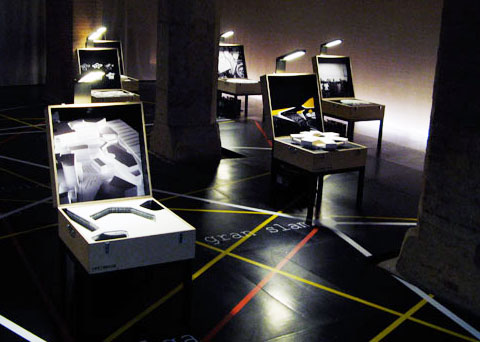
playground exhibition in vicenza, 2008
image © designboom
menil collection master site plan competition
houston, texas, 2008

soria environmental city, first prize competition, 2007
an institutional space able to catalyze initiatives concerning energy and sustainability
in the territory of castilla y león, spain
proposal for the zurich kunsthaus competition, zurich, switzerland, 2008
automotive museum in torrejon de la calzada, spain, 2006
each piece of sheet metal making up the outside frame is made of
the recycled remains of car bodies
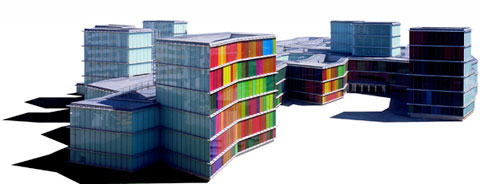
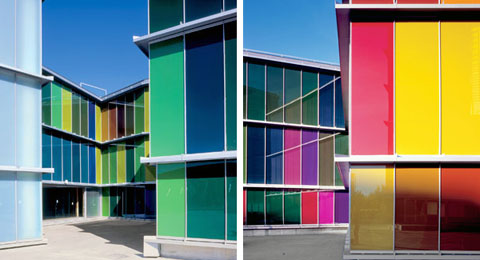 mudac, contemporary art museum of castllia y leon, spain, 2001 - 2004
mudac, contemporary art museum of castllia y leon, spain, 2001 - 2004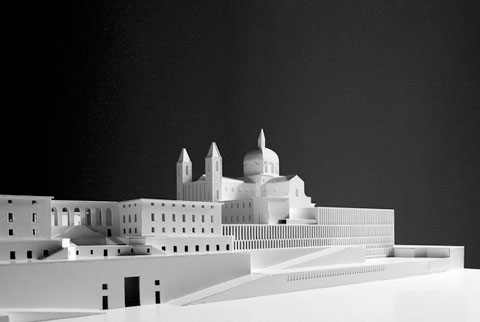
royal collection museum, competition first prize, madrid, spain 2002 - 2003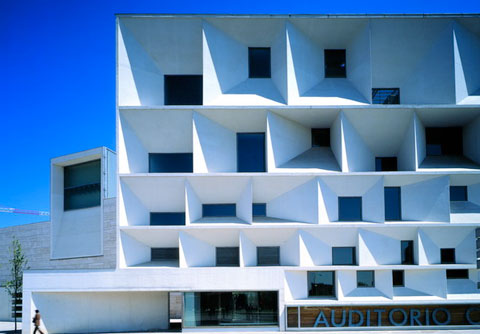
leon auditorium, spain, 1996 - 2002
madrid regional documentary center, spain, 1996 - 2002
swimming centre in san fernando de henares, madrid, spain, 1994 - 1998
(answers by emilio tunon alvarez)
what is the best moment of the day?
when I finish working at my office and I have the chance
to walk home, spending 20 minutes reflecting on what
I have done during the day and what I think I will do.
what kind of music do you listen to at the moment?
music by rick sutton.
once I turned 40 I started learning piano and tried to play
thatkind of music. so now I don't just listen, I study it.
do you listen to the radio?
no, well I hear the radio but I don't listen to it .
when I'm at work I am not able to listen to anything,
the sound just disappears around my head.
what books do you have on your bedside table?
a book from john berger, whom I found to be
an incredible writer. he puts together social conciousness
of the world in a sensitive and high quality manner.
I particularly love when you can enjoy literature and
at the same time reflect about the world.
where do you get news from?
usually from newspapers - we buy two or
three papers a day.
I assume you notice how women dress.
do you have any preferences?
there is a famous designer called sybilla that works
also in japan and I think she a wonderful
designer for women.
what kind of clothes do you avoid wearing?
I never think about that, its something I'm not
concerned about. maybe I prefer comfortable
clothing.
do you have any pets?
no we don't, we have daughters (laughs).
when you were a child,
did you want to become a architect?
I wanted to be an engineer.
where do you work on your designs and projects?
just in the office.
do you discuss your work with other architects?
we don't mainly discuss architecture with our friends,
we discuss life and all those other things.
describe your style, like a good friend of yours would
describe it.
every project needs a surprise and we would like
to discover that, lets say through the form, the materials
and the relationship we have with it.
our work is the pursue of equality and diversity.
it's a subtle game of differences and similarities.
this allows flexible use by either groups or individuals.
often space is defined by a double presence,
a border that exists as two spaces, fluid and gentle.
instead of presenting an architecture of physical constraints,
we like a design that creates intermediacy.
please describe an evolution in your work,
from your first projects to the present day.
nowadays I would say there is much more interest
in 'social concerns'. the geometry we use are more
focussed on people's live rather than a structure.
we are very concerned with the environmental process
but in classic terms. for us it has been important to learn
from 20 years ago how buildings were constructed,
insulated and with what durable materials.
that's the direction we are heading into.
why do you show suitcases in your
playground exhibition in vicenza?
the exhibition project started in harvard, where we were
teaching, 3 years ago. we thought about our work,
and we thought we might want to change it. what happens
if we relocate? we thought of our work in terms of a sort
of retrospective. what would happen if we put each of
our project in a 'duchamp box'?
how do ecology and sustainability play
a role in your work?
just an example, once, we used compacted discarded
cars to build the facade of an automotive museum.
this project represents our attitude towards a recycling
process, towards a more creative re-use of discards.
the automotive museum in torrejon de la calzada,
spain is located next to a big car recycling factory.
each piece of sheet metal making
up the outside frame is made of the recycled remains
of car bodies, which, at the end of their useful lives,
and after having the engine and other recoverable
parts removed, were cleaned and crushed to become
an essential part of the cladding. links it to the past,
the history of cars.
who would you like to design something for?
we never expect anything in particular.
well, or better, we like to expect the unexpected.
we do our work just like a shoemaker makes shoes.
do you only work for and with people you like?
practically all of our projects are results of competitions.
when you work through competitions, you have previously
chosen the client sector you wish to work with. you can
pose a problem and elaborate the first idea, an idea in
which we believe strongly, within a certain freedom.
you have a longer time frame for that.
and last but not least we have a more democratic
access to projects. to us it seems to be the best way
of working.
is there any designer and/or architect from the past,
you appreciate a lot?
we love le corbusier and the smithsons
(alison and peter smithson)
but if we have to tell you what buildings we love
the most it would be the mosque in cordoba and
the alhambra in granada, yes, both in spain.
and those still working / contemporary?
kazuyo sejima,
we always look carefully at what she is doing.
please define in the field of architecture
'professionalism'.
for us there are three main fields of architecture.
there is the production of architecture itself,
the process and final building;
there is the communication of both, publications
and conferences;
and there is the educational aspect - teaching architecture.
also 'professional' architecture means that you have
to consider many spaces, not only the physical space,
but also the cultural, intellectual, social, political
space. quality lies in elaborating a simple concept
which can unify all those spaces.
what advice would you give to the young?
first of all, to feel comfortable with life.
then to open your eyes and open your ears that is essential.
observe and reflect about what you are seeing.
what are you afraid of regarding the future?
its better to not to live with fear. 

© All Right Reserved. Copyright © ООО Информагентство СА "Архитектор" ©
Свидетельство о регистрации ИА №ФС1-02297 от 30.01.2007
Управление Федеральной службы по надзору за соблюдением законодательства в сфере массовых коммуникаций и охране культурного наследия по Центральному Федеральному округу.

